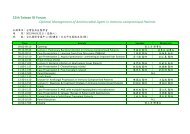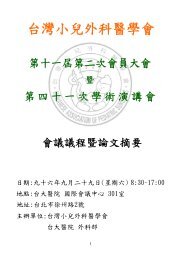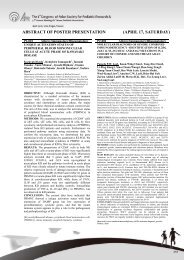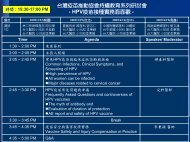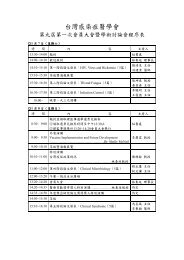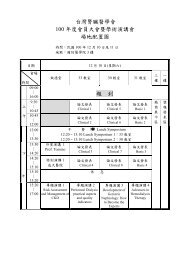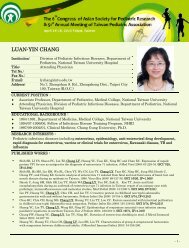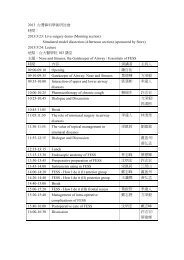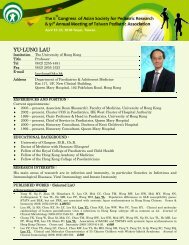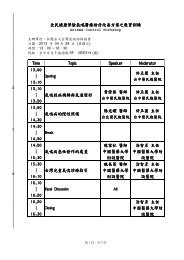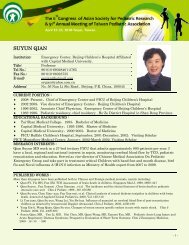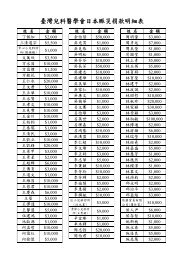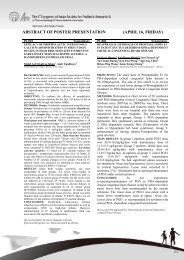ABSTRACT OF INVITED LECTURES AND ORAL PRESENTATION
ABSTRACT OF INVITED LECTURES AND ORAL PRESENTATION
ABSTRACT OF INVITED LECTURES AND ORAL PRESENTATION
- No tags were found...
You also want an ePaper? Increase the reach of your titles
YUMPU automatically turns print PDFs into web optimized ePapers that Google loves.
PL-03TRANSLATIONAL RESEARCH: FROMBENCHSIDE TO BEDSIDEYonghao Gui, MD., MSc.Children’s Hospital of Fudan University, Shanghai, China 201102PL-04CANCER PREVENTION – STARTING FROMCHILDHOODMei-Hwei Chang, M.D.Department of Pediatrics, National Taiwan University Hospital, Taipei, TaiwanThe translation of theoretical knowledge and experimentalbreakthroughs into the clinical practice of medicine hasalways been difficult. During the past few decades, growingbarriers between clinical and basic research, the size of theacquired scientific data and the ever-increasing complexitiesof conducting clinical research according to governmentregulations and financial constraints, have made thistranslation even more problematic. Translational research hasemerged as a scientific discipline rather recently, in order tobridge the gap between basic and clinical research. Thetranslational researcher functions as the link or translatorbetween the two branches having experience of both fields andtranslating the messages of one branch into the language of theother. The translational researcher can identify the underlyingclinical consequences of the new discoveries of basic research,and can relate them to the confirmed needs of the clinician.Thus, translational research is currently defined as the processof transforming research innovations into new health productsand diagnostic and therapeutic methods, and is usually carriedout in academic institutions.Recent studies indicated that the discoveries in basic orclinical science take a very long time to translate towidespread application and to improved health of individuals.There are two major “translational blocks” impeded theincorporation of scientific discoveries: 1. translation formbasic science to human studies (new methods for diagnosis,treatment or prevention). 2. translation form clinical studies toactual clinical practice decision making. Pediatrics aboundswith examples of the slow translation of research to improvedhealth care. Despite research highlighting preventable causesof childhood asthma, successive national and internationalguidelines for asthma management, and effective therapies,studies continue to document the rising prevalence of asthma,variability in the level of health care received by children, andalso the significant of asthma morbidity. Investigations haveuncovered genetic, biologic, and behavioral cause ofchildhood obesity or autism, yet effective human studies areneeded to prevent and successfully manage these disease, Inthe long term, only education can modify mentalities andperceptions. Through educational interventions new strategiesof clinical and translational research can be implemented at alllevels, including collaboration between scientists, clinicians,researchers and stakeholders (industry, society, state, healthsystems). Via education, the hospital manager will cease toidentify clinical research with low-priority andnon-cost-effective expense. Society will understand the truebenefits of medical research. Scientists and clinicians willaccommodate to public control and transparency of prioritiesand fund expenses. Finally, industry will invest more, andthose in medical fields will learn to recognize the necessitiesof private sector investment. But again, as mentioned before,the roles of translational clinicians and researchers are central.Cancer is a leading cause of death in human. Main riskfactors of cancer includes: (1) Host genetic factors.;(2)Lifestyle or environmental factors, such as food, physicalactivities, smoking, alcohol, aflatoxin, arsenic, asbestos,ultraviolet, and ionizing radiation, etc.; (3)Infection: such ascarcinogenic virus, bacteria, or parasite infection.While the incidence of cancer is much higher in adults, theaction of cancer prevention can be started from childhood.Besides screening of the genetic factors to find out the highrisk groups for specific cancers, establishment of healthylife styles starting from childhood to prevent obesity,exposure to environmental carcinogens such as smoking,alcohol, radiation, etc. are also very important.Among the infectious agents with carcinogenic evidences,successful vaccines have been developed for hepatitis Bvirus (HBV) and human papilloma virus (HPV). Vaccinesare still developing for other viruses (such as, hepatitis Cvirus, EB virus, human immunodeficiency virus), andbacteria (H. pylori).Immunization against carcinogenic biologic agents is a costeffective way to prevent cancer. HBV vaccine is the firsthuman cancer preventive vaccine with high efficacy. Livercancer is one of the five leading causes of cancer deathglobally. Due to mother-to-infant transmission as the mainroute of chronic HBV infection and liver cancer,immunization since birth is the best timing to prevent livercancer. We have provided evidences to support the successof reduction of chronic HBV infection and liver cancer inchildren. Recently, we have also proved that the cancerpreventive effecto fo HBV immunization has been extendedfrom children to adolescents of 6 to 19 years old. Thisexperience could be shared with other cancer preventivevaccines, such as HPV vaccine to prevent cervical cancer,in the future.In conclusion, cancer preventive works should be startedfrom early childhood.98



